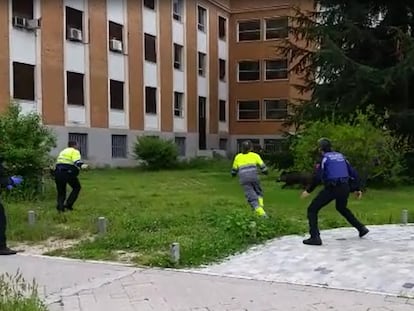The rare bat that showed up on a cactus in downtown Mexico City
An endangered species has been seen in the heart of the Mexican capital. How did animals known for their love of quiet surroundings find their way to a Latin American megalopolis?


It’s a question that often echoes in Rodrigo Medellín’s brain these days: “What on earth is a rare long-tongued bat doing in the middle of downtown Mexico City?”
Last November, Medellín and his team at the National Autonomous University of Mexico’s (UNAM) Institute of Ecology documented the presence of several specimens of Choeronycteris mexicana, a bat species listed as endangered since 1994. The bats showed up, of all places, at the city’s Chapultepec Zoo, feeding on cactus pollen in a hyena enclosure.
This question of how an endangered bat can thrive in an urban setting is not as esoteric as it sounds. Development and deforestation are driving the only flying mammal on Earth from natural habitats in caves and forests. Bats help to pollinate plants and spread seeds over wide areas, regenerating the land, and are a vital part of the ecosystem. “Humans have invaded practically all of the world’s ecosystems. We feel we are the owners of creation,” said Medellín in a phone interview. “That is an illusion, and the truth is that we are invaders of places that animals and plants occupied for millions of years before we began to exterminate them.”
Wildlife is waving a white flag at us and asking us for a chance to continue offering us the benefits it has offered for time immemorialRodrigo Medellín, biologist
Medellín’s fascination with this find, therefore, is linked to the phenomenon of a bat reclaiming what was once its own. Mexico City alone is home to about 20 different types of bats. But Choeronycteris mexicana is a more enigmatic species than most. Weighing up to 25 grams, this tiny mammal is usually found in temperate climates in the southern United States, Mexico, Guatemala, Honduras, El Salvador and a small area of Nicaragua. While other bats can be found in colonies of thousands or hundreds of thousands, long-tongued bats tend to travel in very small groups of 15 to 20 at a time. Because of this, scientists have had trouble documenting their migration routes and rebuilding their population numbers. “They appear and disappear,” Medellín explained. “Almost nothing is known about them; this animal is a mystery.”
There are signs that more and more species are adapting to urban living conditions. Medellín said that if you stand in front of a Mexico City street lamp with a white light, of the kind that moths and other insects are naturally drawn to, it won’t be long before you spot a bat. There are thousands that inhabit the area around the capital’s Zócalo, the largest city square in Latin America. The Choeronycteris mexicana, along with similar long-nosed bats, feed on nectar and pollen, so the cactus bed near the hyenas’ lair was no coincidence. They have been seen in the botanical garden of Medellín’s university, UNAM, but also in a residential area near two of Mexico City’s busiest roads, Viaducto Río La Piedad and Tlalpan.

These are not particularly green spaces, adding to the mystery over the behavior of these animals. How can bats identify a food source in seemingly inhospitable terrain? Medellín has studied maguey bats, so called because they feed on magueys or agaves, the plants from which tequila and mezcal are produced, and discovered that they can fly six to eight hours per day in search of food, covering a 100-kilometer radius. His hypothesis is that the long-tongued bat can cover similar distances and can “scan” the terrain in the moonlight, detecting plants for food. Its fuel? “Plain water with sugar,” said an amazed Medellín.
The UNAM is already planning a joint project with Tel Aviv University to track the movements of this mammal with GPS technology, but due to its diminutive size a tiny tracking device is required, weighing little more than one gram. The idea is that the transmitter will be activated for an hour every week and that after a year, a complete map of its movements will be available, which may provide new clues behind the enigma of this animal. The technology is already being tested in Israel on another bat species, and if the results are satisfactory, it will launch in Mexico in 2022.
When Medellín was just 12 years old he managed to convince his mother to let him appear on the “64,000 pesos show”, a Mexican version of “Who Wants to Be A Millionaire?” Medellín did not make it to the last round, but went on to study and promote animal conservation, especially bats, for almost 50 years. These days, the 64,000-peso question is how to ensure the long-term survival of these bats. The main threat to bats’ existence is the destruction of their habitats. “We are at a very important crossroads,” Medellín said. “Wildlife is waving a white flag at us and asking us for a chance to continue offering us the benefits it has offered for time immemorial.” After writing more than 200 articles and more than 50 books on conservation, ecology and diversity, Medellín, sometimes known as “Mexico’s Batman,” is clear: “They are asking us to stop. They were here before us”.
The Covid-19 pandemic has raised the issue of bats spreading disease, as it is believed the virus originated in bats before passing through an intermediary species and finally infecting a human. Bats have incredibly robust immune systems that means they can live with viruses that can kill human beings, but that is hardly their fault, Medellín argued. The benefits of these animals can be seen from the food we eat (pollination) to the clothes we wear (controlling insect populations). “Bats are the most unjustly treated animals in existence,” said Medellín.
Tu suscripción se está usando en otro dispositivo
¿Quieres añadir otro usuario a tu suscripción?
Si continúas leyendo en este dispositivo, no se podrá leer en el otro.
FlechaTu suscripción se está usando en otro dispositivo y solo puedes acceder a EL PAÍS desde un dispositivo a la vez.
Si quieres compartir tu cuenta, cambia tu suscripción a la modalidad Premium, así podrás añadir otro usuario. Cada uno accederá con su propia cuenta de email, lo que os permitirá personalizar vuestra experiencia en EL PAÍS.
¿Tienes una suscripción de empresa? Accede aquí para contratar más cuentas.
En el caso de no saber quién está usando tu cuenta, te recomendamos cambiar tu contraseña aquí.
Si decides continuar compartiendo tu cuenta, este mensaje se mostrará en tu dispositivo y en el de la otra persona que está usando tu cuenta de forma indefinida, afectando a tu experiencia de lectura. Puedes consultar aquí los términos y condiciones de la suscripción digital.
More information
Archived In
Últimas noticias
Most viewed
- Reinhard Genzel, Nobel laureate in physics: ‘One-minute videos will never give you the truth’
- Oona Chaplin: ‘I told James Cameron that I was living in a treehouse and starting a permaculture project with a friend’
- Pablo Escobar’s hippos: A serious environmental problem, 40 years on
- Why we lost the habit of sleeping in two segments and how that changed our sense of time
- Charles Dubouloz, mountaineering star, retires at 36 with a farewell tour inspired by Walter Bonatti










































